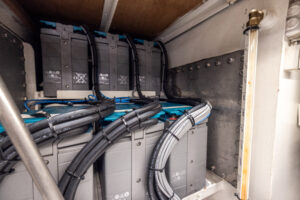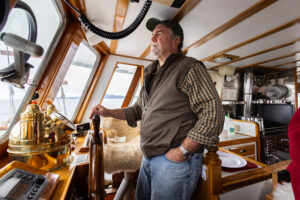In the past 20 years, marine electronics advanced by leaps and bounds with a rapid introduction of new products. In the past few years, though, we’ve seen something different. Electronics manufacturers are changing their hardware much less frequently, and instead are adding new capabilities through software updates.
As the equipment on your boat ages past 10 years old, you may be starting to encounter limitations. These can include the availability of updated cartography, the ability to integrate with newer technologies such as AIS and satellite weather, or slow performance and less-reliable operation.

So, maybe it’s time for an upgrade. But what does that mean? Is it necessary to replace all the equipment and start from scratch?
Not necessarily. A full electronics refit for a cruising boat can easily total $20,000 to $50,000. That’s not in every cruiser’s budget. Also, each boat and has its own considerations.
Here’s a starting point for how to attack a project on your boat.

Augment Existing Equipment
At the lowest end of the cost spectrum is augmenting what’s already there. A tablet running navigation apps like Aqua Map, Navionics Boating HD or TZ iBoat provides access to updated cartography, the ability to overlay AIS data, crowd-sourced data from ActiveCaptain and Waterway Guide, and more. These apps and their charts cost less than installed equipment, even when factoring in the cost of the tablet itself.
To leverage equipment such as GPS receivers, depthfinders and AIS, you will need a Wi-Fi connection between the tablet and your installed equipment. Many recent AIS transceivers include Wi-Fi gateways, or you can get a separate NMEA 2000- or NMEA 0183-to-Wi-Fi gateway.
But, tablets do come with their own compromises. The displays are typically dimmer than what you find on installed equipment, and they can be difficult to read in direct sunlight. Many tablets can’t be viewed at all through polarized sunglasses because of the orientation of the tablet display’s polarizer. Plus, reliability isn’t as good as with a fixed chartplotter or multifunction display. A dead battery in the tablet means it will need to charge before it can be used.

Tablets are also prone to overheating in direct sunlight, rendering them nonfunctional until they’ve cooled down. And, the apps tend to be better-tested for use with installed equipment. Several times, I’ve found that an update breaks the app until the developer releases a new version.
Because of these compromises, I like having a tablet to augment other navigation equipment, not as the sole system.
Selective Replacement
Modern multifunction displays are designed to integrate all navigation functions on a single display or several networked displays. All that integration requires compatible equipment, and it’s common for a new display to work only with the latest equipment. If you want to display radar, for instance, then you will need to upgrade your radar unit too.
That approach gets expensive quickly, which is why many boaters retain a working radar unit and its display. This choice means the radar won’t be displayed on a new multifunction device. It’s an option that works well if your cruising isn’t likely to be radar-dependent. On the other hand, if you’re cruising at night on a regular basis and expect to cruise in fog or other limited-visibility situations, a new radar unit is likely to be money well spent.
Radar isn’t the only spot that can stretch your budget. Most boaters I know use their autopilot on heading hold, not following a route. If that’s the case for you, then integration with a new multifunction display isn’t particularly critical. Sticking with your existing autopilot can save you thousands of dollars.
Also consider VHF radios and AIS. These units communicate with other equipment via NMEA 0183 and/or NMEA 2000. The communications are standardized, so VHF radios and AIS transceivers don’t benefit from being the same brand as the rest of your equipment.

Other Components
Frequently overlooked components in a refit include depthsounders and fishfinders. Depthsounders often connect to other equipment via NMEA 0183 or NMEA 2000, but many older systems use proprietary networks from companies such as Raymarine and Simrad. Those systems can be easily integrated by way of a converter to an NMEA 2000 network.
Transducers connected to fishfinders usually use a brand-specific connector; changing brands can necessitate changing transducers as well. Many fishfinder manufacturers use Airmar transducers with their own connectors at the end, and in some cases, the connector can be changed with an adapter or by replacing the cable using Airmar’s mix-and-match cabling system.
Know Your Equipment
The best way to be prepared if you encounter trouble on the water is to have a strong working knowledge of your equipment. You should know where it’s installed, how it’s powered and how it’s all connected.
Many problems are the result of simple issues: a blown fuse or circuit breaker, a cable that has worked its way loose. If you know where to look, you can often troubleshoot quickly, without waiting days or weeks for a pro to get on board and help.

IOT SOLUTIONS
The past two years have brought dramatic changes to many of our lives, including many more boaters being able to work aboard instead of in an office. This shift, in turn, has increased our reliance on internet connectivity.
There’s real hope that in the next few years, solutions such as Starlink’s constellation of low-earth-orbit satellites will deliver fast, reliable, truly unlimited connectivity. But right now, our best bet is the 4G and 5G cellular networks.
Raymarine’s recently introduced YachtSense Link is intended to be an all-in-one monitoring, control and connectivity solution for boats. Navigation equipment, entertainment systems, computers, mobile devices and more can connect to YachtSense Link. The system includes a high-performance, four-in-one antenna with GPS, 3G, 4G and Wi-Fi elements that will mount high on the boat for maximum reception. The system can also enable monitoring and control of onboard systems.
This article was originally published in the May/June 2022 issue.





